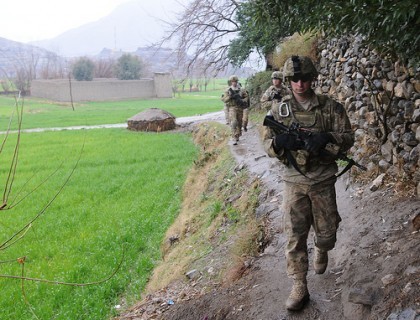A few months ago we broke the story on how Congress was inserting language into the 2010 Defense Authorization Bill to force the Services to develop joint combat uniforms. Well, almost three months later, here it is.
In Sec. 352. Policy on ground combat and camouflage utility uniforms, this is the language verbatim from the bill, except that we have deleted line numbers in order to improve the readability of the data.
“(a) ESTABLISHMENT OF POLICY.—It is the policy of the United States that the design and fielding of all future ground combat and camouflage utility uniforms of the Armed Forces may uniquely reflect the identity of the individual military services, as long as such ground combat nd camouflage utility uniforms, to the maximum extent practicable—
(1) provide members of every military service an equivalent level of performance, functionality, and protection commensurate with their respective as signed combat missions;
(2) minimize risk to the individual soldier, sailor, airman, or marine operating in the joint battlespace; and
(3) provide interoperability with other components of individual war fighter systems, including body armor and other individual protective systems.
(b) COMPTROLLER GENERAL ASSESSMENT.—The Comptroller General shall conduct an assessment of the ground combat uniforms and camouflage utility uniforms currently in use in the Department of Defense. The assessment shall examine, at a minimum, each of the following:
(1) The overall performance of each uniform in various anticipated combat environments and theaters of operations.
(2) Whether the uniform design of each uniform conforms adequately and is interoperable with currently issued personal protective gear and body armor.
(3) Costs associated with the design, development, production, procurement, and fielding of existing service-specific ground combat and camouflage utility uniforms.
(4) Challenges and risks associated with fielding members of the Armed Forces into combat theaters in unique or service-specific ground combat or camouflage utility uniforms, including the tactical risk to the individuals serving in individual augmentee, in-lieu of force, or joint duty assignments of use of different ground combat uniforms in a combat environment.
(5) Implications of the use of patents and other proprietary measures that may preclude sharing of technology, advanced uniform design, camouflage techniques, and fire retardence.
(6) Logistical requirements to field and support forces in varying combat or utility uniforms.
(c) REPORT REQUIRED.—Not later than 180 days after the date of the enactment of this Act, the Comptroller General shall submit to the congressional defense committees the results of the assessment conducted under subsection (b).
(d) REQUIREMENT FOR JOINT CRITERIA.—In support of the policy established in subsection (a), the Secretaries of the military departments, consistent with the authority set out in subtitles B, C, and D of title 10, United States Code, shall establish joint criteria for future ground combat uniforms by not later than 270 days after the Comptroller General submits the report required under subsection (c). The joint criteria shall take into account the findings and recommendations of such report and ensure that new technologies, advanced materials, and other advances in ground combat uniform design may be shared between the military services and are not precluded from being adapted for use by any military service due to military service-unique proprietary arrangements.”
So essentially, this gives the services a little over a year to figure out how they will go about establishing “joint criteria”. To me, the most important statement in all of this is the last bit about “service-unique proprietary arrangements”. This is an obvious shot at forcing the services to share.
On a side note, according to the conference report, the bill also “Requires DOD to establish specific budget line items within the procurement and research, development, test and evaluation (RDT&E) accounts for body armor. This will improve accountability and increase transparency into long-term investment strategies for body armor as well as facilitate the advancement of lighter-weight technologies.”





 U.S. Rep. John P Murtha from Pennsylvania’s 12th District died today of complications from gallbladder surgery at a Virginia Hospital Center in Arlington, Va. He was 77.
U.S. Rep. John P Murtha from Pennsylvania’s 12th District died today of complications from gallbladder surgery at a Virginia Hospital Center in Arlington, Va. He was 77.













































































































